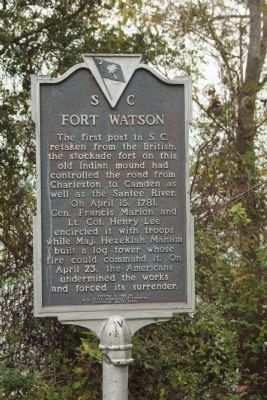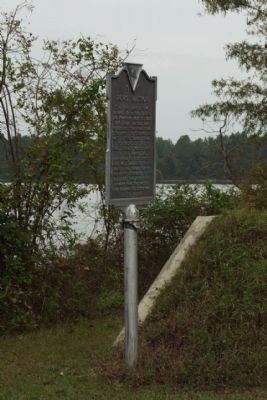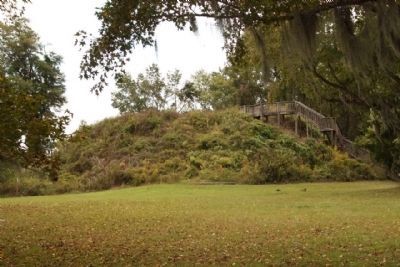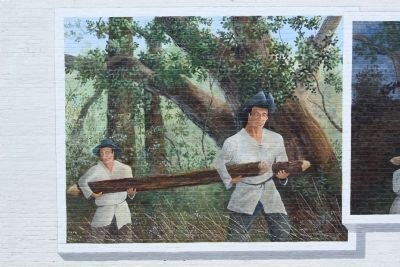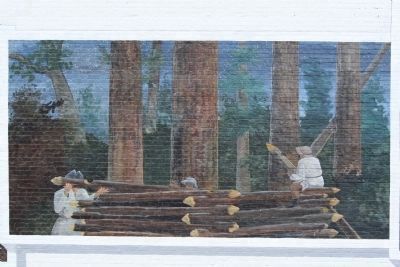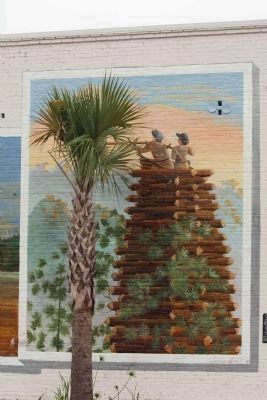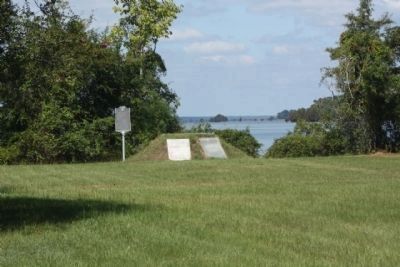Summerton in Clarendon County, South Carolina — The American South (South Atlantic)
Fort Watson
Erected 1963 by S.C. Forestry Commission, Parks Division. (Marker Number 14-1.)
Topics. This historical marker is listed in these topic lists: Forts and Castles • War, US Revolutionary. A significant historical month for this entry is April 1918.
Location. 33° 31.966′ N, 80° 25.91′ W. Marker is in Summerton, South Carolina, in Clarendon County. Marker is on Fort Watson Road (State Highway 14-803), on the left when traveling west. Located Approx. .5 miles west of US 301, US15 - 1 mile north of I-95 interchange 102. Touch for map. Marker is in this post office area: Summerton SC 29148, United States of America. Touch for directions.
Other nearby markers. At least 8 other markers are within 7 miles of this marker, measured as the crow flies. 2nd Battle of Fort Watson (here, next to this marker); Swamp Fox (a few steps from this marker); Fort Watson: (approx. 0.4 miles away); Santee National Wildlife Refuge (approx. half a mile away); a different marker also named Fort Watson (approx. half a mile away); Liberty Garden (approx. 3.4 miles away); Liberty Hill Church / Pioneers in Desegregation (approx. 4.7 miles away); Anne Custis Burgess (approx. 6.7 miles away). Touch for a list and map of all markers in Summerton.
Regarding Fort Watson. Santee Indian Mound was part of a mound village complex; it was probably a burial and/or temple mound, likely constructed in some cultural period between 1200-1500 AD. Santee Indian Mound and a probable low earthwork remain intact except for the superposition of eighteenth- century fortifications on top of the mound. The fortification, British Revolutionary War post Fort Watson, was built from 30 to 50 feet high atop the mound. In 1780, Francis Marion and Light Horse Harry Lee decided to capture the fort. Bombardment was out of the question, for the Americans were without artillery, but Colonel Maham,one of Marion’s officers, proposed building a log tower higher than Fort Watson. Hidden by trees, men hewed logs and the tower was erected in a single night. At dawn a shower of lead poured down into the enemy enclosure, effecting
a quick victory. Fort Watson was the first fortified British military outpost in South Carolina recaptured by patriot forces after the British occupation of 1780. There are no remains of Fort Watson on the site. Listed in the National Register July 29, 1969. (S.C. Dept. of Archives and History)
National Register of Historic Places :
Santee Indian Mound and Fort Watson ** (added 1969 - Site - #69000164)
♦ Historic Significance: Information Potential
♦ Area of Significance: Prehistoric
♦ Cultural Affiliation: Native American
♦ Period of Significance: 1499-1000 AD
♦ Owner: State
♦ Historic Function: Domestic, Funerary, Religion
♦ Historic Sub-function: Ceremonial Site, Graves/Burials, Village Site
♦ Current Function: Landscape
♦ Current Sub-function: Park
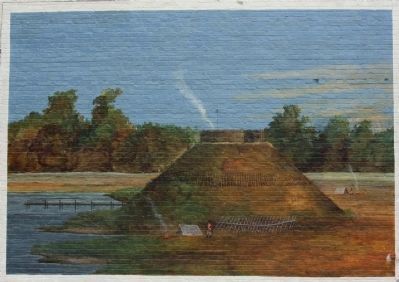
Photographed By Mike Stroud, October 11, 2009
6. Fort Watson , From the Swamp Fox Murals Trail
In his memoirs,(Lt. Col. Henry) Lee described the tower as a ``large, strong oblong pen, to be covered on the top with a floor of logs, and protected on the side opposite to the fort with a breastwork of light timbers.'' The use of the tower to attack a fortified position is an old practice known to the Romans. But to Hezekiah Maham must go the credit for re-inventing its use in the New World.
Credits. This page was last revised on November 15, 2020. It was originally submitted on October 27, 2009, by Mike Stroud of Bluffton, South Carolina. This page has been viewed 1,837 times since then and 33 times this year. Last updated on April 20, 2016, by David Graff of Halifax, Nova Scotia. Photos: 1, 2, 3, 4, 5, 6, 7. submitted on October 27, 2009, by Mike Stroud of Bluffton, South Carolina. 8. submitted on October 3, 2011, by Mike Stroud of Bluffton, South Carolina. • Bill Pfingsten was the editor who published this page.
